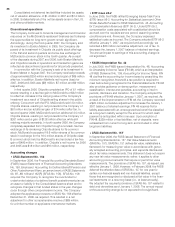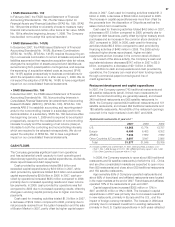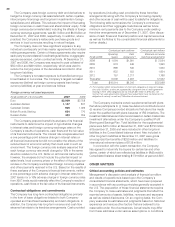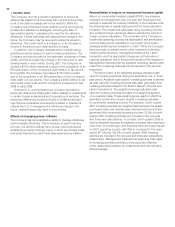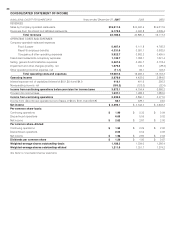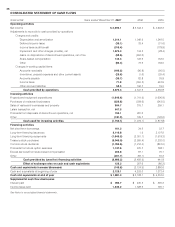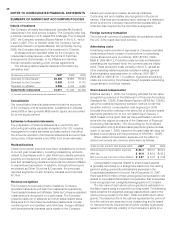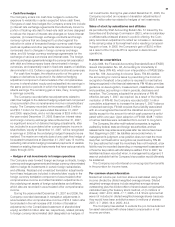McDonalds 2007 Annual Report Download - page 43
Download and view the complete annual report
Please find page 43 of the 2007 McDonalds annual report below. You can navigate through the pages in the report by either clicking on the pages listed below, or by using the keyword search tool below to find specific information within the annual report.The Company reviews its fi nancial reporting and disclosure
practices and accounting policies quarterly to ensure that they
provide accurate and transparent information relative to the
current economic and business environment. The Company
believes that of its signifi cant accounting policies, the following
involve a higher degree of judgment and/or complexity:
• Property and equipment
Property and equipment are depreciated or amortized on a
straight-line basis over their useful lives based on manage-
ment’s estimates of the period over which the assets will generate
revenue (not to exceed lease term plus options for leased
property). The useful lives are estimated based on historical
experience with similar assets, taking into account anticipated
technological or other changes. The Company periodically
reviews these lives relative to physical factors, economic factors
and industry trends. If there are changes in the planned use
of property and equipment, or if technological changes occur
more rapidly than anticipated, the useful lives assigned to these
assets may need to be shortened, resulting in the recognition of
increased depreciation and amortization expense or write-offs
in future periods.
• Share-based compensation
The Company has a share-based compensation plan which
authorizes the granting of various equity-based incentives
including stock options and restricted stock units (RSUs) to
employees and nonemployee directors. The expense for these
equity-based incentives is based on their fair value at date of
grant and generally amortized over their vesting period.
The fair value of each stock option granted is estimated on
the date of grant using a closed-form pricing model. The pricing
model requires assumptions, such as the expected life of the
stock option and expected volatility of the Company’s stock
over the expected life, which signifi cantly impact the assumed
fair value. The Company uses historical data to determine these
assumptions and if these assumptions change signifi cantly for
future grants, share-based compensation expense will fl uctuate
in future years. The fair value of each RSU granted is equal
to the market price of the Company’s stock at date of grant less
the present value of expected dividends over the vesting period.
• Long-lived assets impairment review
Long-lived assets (including goodwill) are reviewed for impairment
annually in the fourth quarter and whenever events or changes
in circumstances indicate that the carrying amount of an asset
may not be recoverable. In assessing the recoverability of the
Company’s long-lived assets, the Company considers changes
in economic conditions and makes assumptions regarding
estimated future cash fl ows and other factors. Estimates of
future cash fl ows are highly subjective judgments based on the
Company’s experience and knowledge of its operations. These
estimates can be signifi cantly impacted by many factors
including changes in global and local business and economic
conditions, operating costs, infl ation, competition, and con-
sumer and demographic trends. A key assumption impacting
estimated future cash fl ows is the estimated change in
comparable sales. If the Company’s estimates or underlying
assumptions change in the future, the Company may be
required to record impairment charges.
When the Company sells an existing business to a develop-
mental licensee, it determines when these businesses are “held
for sale” in accordance with the requirements of SFAS No. 144,
Accounting for the Impairment or Disposal of Long-lived Assets.
Impairment charges on assets held for sale are recognized when
management and, if required, the Company’s Board of Directors
have approved and committed to a plan to dispose of the as-
sets, the assets are available for disposal, the disposal is prob-
able of occurring within 12 months, and the net sales proceeds
are expected to be less than the assets’ net book value, among
other factors. An impairment charge is recognized for the dif-
ference between the net book value of the business (including
foreign currency translation adjustments recorded in accumulated
other comprehensive income in shareholders’ equity) and the
estimated cash sales price, less costs of disposal.
An alternative accounting policy would be to recharacterize
some or all of any loss as an intangible asset and amortize
it to expense over future periods based on the term of the
relevant licensing arrangement and as revenue is recognized
for royalties and initial fees. Under this alternative for the Latam
transaction, approximately $900 million of the $1.7 billion
impairment charge could have been recharacterized as an
intangible asset and amortized over the franchise term of
20 years, resulting in about $45 million of expense annually.
This policy would be based on a view that the consideration for
the sale consists of two components–the cash sales price and
the future royalties and initial fees.
The Company bases its accounting policy on management’s
determination that royalties payable under its developmental
license arrangements are substantially consistent with market
rates for similar license arrangements. The Company does not
believe it would be appropriate to recognize an asset for the
right to receive market-based fees in future periods, particularly
given the continuing support and services provided to the
licensees. Therefore, the Company believes that the recognition
of an impairment charge based on the net cash sales price
refl ects the substance of the sale transaction.
• Litigation accruals
From time to time, the Company is subject to proceedings,
lawsuits and other claims related to competitors, customers,
employees, franchisees, government agencies, intellectual
property, shareholders and suppliers. The Company is required
to assess the likelihood of any adverse judgments or outcomes
to these matters as well as potential ranges of probable losses.
A determination of the amount of accrual required, if any, for
these contingencies is made after careful analysis of each matter.
The required accrual may change in the future due to new
developments in each matter or changes in approach such as
a change in settlement strategy in dealing with these matters.
The Company does not believe that any such matter currently
being reviewed will have a material adverse effect on its fi nancial
condition or results of operations.
41







